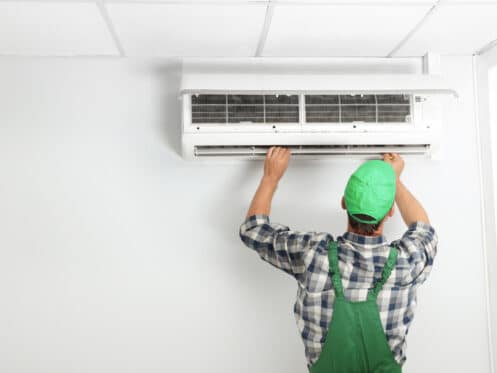If your AC feels like it’s barely pushing out any air, you’re not alone. Low airflow is a common AC problem that people in Plainsboro Township deal with, especially during the seasonal switch from summer to fall.
It’s one of those issues that sneaks up gradually; you might notice one room isn’t cooling as well as the others, or maybe the system runs longer than usual, but still doesn’t feel right. That weak stream of air signals that something in your AC system isn’t working the way it should.
When airflow drops, comfort goes down, and utility bills can go up without you even realizing it. Low airflow keeps your AC from doing its job properly and can put added stress on the system. Over time, that can mean bigger problems or even system failure if it’s not handled.
Tackling airflow issues early on prevents more expensive trouble later and helps keep your home cool for longer stretches of the year, especially in areas like Plainsboro Township, where the weather can still call for AC use well into the fall. Let’s walk through some common causes and how they can be addressed.
Check And Replace Air Filters
One of the first things to look at when airflow is weak is your air filter. This small part plays a big role in how your AC performs. When a filter is clogged with dust, pet hair, or other debris, it blocks air from passing through freely. That means less air moves through your vents, and your system has to work harder to keep up.
Filters are out of sight, so they’re easy to forget, but they really do impact system performance. In some cases, people assume something major is wrong with their AC when the air filter is just overloaded with buildup. Filters not only affect airflow, but they can also influence indoor air quality and even lead to frozen evaporator coils if airflow is restricted for too long.
Here’s how to stay on top of it:
– Locate your AC filter, which is usually found behind a vent grille or inside the HVAC unit
– Remove the filter and hold it up to the light. If you can’t see light through it, it needs to be replaced
– If your unit uses reusable filters, follow the manufacturer’s directions to clean them. Let them dry fully before reinstalling
– Make a habit of checking your filter once a month during high-use seasons, and change it at least every 1 to 3 months
Sometimes, a simple filter change is all it takes to get your AC blowing strong again. If your airflow doesn’t improve after replacing the filter, it’s time to look deeper into the system.
Inspect Ductwork for Leaks and Blockages
If the filter wasn’t the problem, the issue might be hiding in your ductwork. Air ducts are like the roadways your AC uses to move air throughout your house. When those roadways are blocked or leaking, airflow suffers. This is especially true in older homes or systems that haven’t been maintained regularly.
Leaks in the ductwork let cool air escape into spaces like attics or crawl spaces, never making it to the rooms where it’s needed. Blockages can come from dust buildup, loose insulation, or even debris that has fallen or settled inside the ducts over time. If one room in your home feels fine but another barely gets cool, there’s a good chance your ducts need attention.
You can start by doing a visual inspection of your ducts that are exposed. Look for:
– Disconnected joints or holes in exposed duct runs
– Ducts covered in dust or insulation particles, which can signal air leaks
– Closed or blocked vents in the problem areas
– Kinks or bends in flexible ducts that may be restricting airflow
While some minor issues might be visible, most duct problems are hidden behind walls, ceilings, or floors. That’s where a professional inspection really comes in handy. Pinpointing duct leaks or blockages early helps restore airflow, improves your system’s efficiency, and cuts down on uneven cooling. It’s a smart step that gives your AC a better chance at operating the way it was designed to.
Clean the AC’s Evaporator and Condenser Coils
Running into low airflow can sometimes boil down to dirty evaporator and condenser coils. These components have critical roles in ensuring your AC operates smoothly. The evaporator coil is responsible for cooling the air, while the condenser coil releases the heat outside. When these coils get gunked up with dust or grime, your AC’s efficiency takes a nosedive, and you might find the airflow isn’t as strong as it should be.
So, what should you look for? Over time, coils gather dirt and debris from the environment. This buildup blocks the heat exchange process and causes your AC to work harder than necessary to maintain the desired temperature. If you’ve been noticing uneven cooling or constant running, dirty coils might be the culprits.
Here’s a straightforward check:
– Turn off the AC power to stay safe
– Check the evaporator coil inside your ventilation system. If you notice a layer of dust or dirt, it’s time for a clean
– Outside, find the condenser unit. It’s often surrounded by leaves, grass clippings, or other outdoor debris. Clear the area
– Use a soft brush or compressed air to clean surface dust or dirt. Avoid harsh chemicals that might damage the coils
While you can manage light cleaning, professionals have the tools and skills to safely clean coils thoroughly enough without risking any damage. Regular upkeep keeps your system performing well and extends its lifespan.
Ensure Proper Thermostat Functioning
Your thermostat is the command center for all things HVAC. If your home’s airflow isn’t up to par, a malfunctioning thermostat could be the issue. It’s vital to keep an eye on this device to make sure it’s communicating effectively with your AC.
A thermostat that’s out of sync might keep your AC running longer than needed or fail to adjust the temperature correctly. You might think your AC is malfunctioning, but really, it could be the thermostat.
To test your thermostat’s performance:
– Set it a few degrees lower than room temperature and check if the AC kicks on
– If it’s battery-operated, replace the batteries to ensure it’s working properly
– Consider recalibrating the thermostat, which often involves resetting it following the manufacturer’s instructions
For best results, make sure it is not located near windows or direct sunlight as these can give false readings. If you use a programmable model, confirm the timed settings align with your lifestyle to maximize efficiency.
When It’s Time to Call Conway Comfort
Routine maintenance is key to beating low airflow before it becomes a bigger issue. Even with the most diligent efforts, sometimes only a trained pair of eyes can catch subtle problems that might not be immediately visible but affect how your AC functions in the long run.
Don’t overlook the value of scheduling these services. It can mean fewer breakdowns and quieter nights spent in comfort, knowing your AC is ready for any heat Plainsboro Township might throw your way. By taking the time for regular maintenance, you’re not just fixing problems before they start. You’re getting ahead of the seasons and helping your home stay cool exactly when it matters most.
Keep your Hamilton home cool and comfortable by staying ahead with regular AC maintenance. At Conway Comfort Heating & Cooling, we know how important it is to keep your system running smoothly all season long. Schedule your next tune-up with our team and help your AC keep up when it matters most.




